Analysis of Uniqlo's Marketing Strategy: A Comprehensive Report
VerifiedAdded on 2019/09/25
|14
|4869
|289
Report
AI Summary
This report provides a detailed analysis of Uniqlo's marketing strategy, aiming to identify opportunities for improvement and increased sales volume. The study begins with an introduction to Uniqlo, its mission and vision, followed by a literature review exploring marketing strategies, analysis tools, and the marketing mix. The methodology section outlines the research design, including the use of case study methods, customer surveys, and a mixed-method approach. The data analysis section includes PESTLE, STEEPLE, market segmentation, competitor analysis, and SWOT analysis. The findings highlight competitive and growth strategies, followed by recommendations and a conclusion. The report emphasizes the importance of strategic marketing, promotional activities, and understanding the target audience to achieve the company's objectives. The report is a comprehensive exploration of Uniqlo's marketing landscape, offering valuable insights for enhancing its market position and revenue generation.
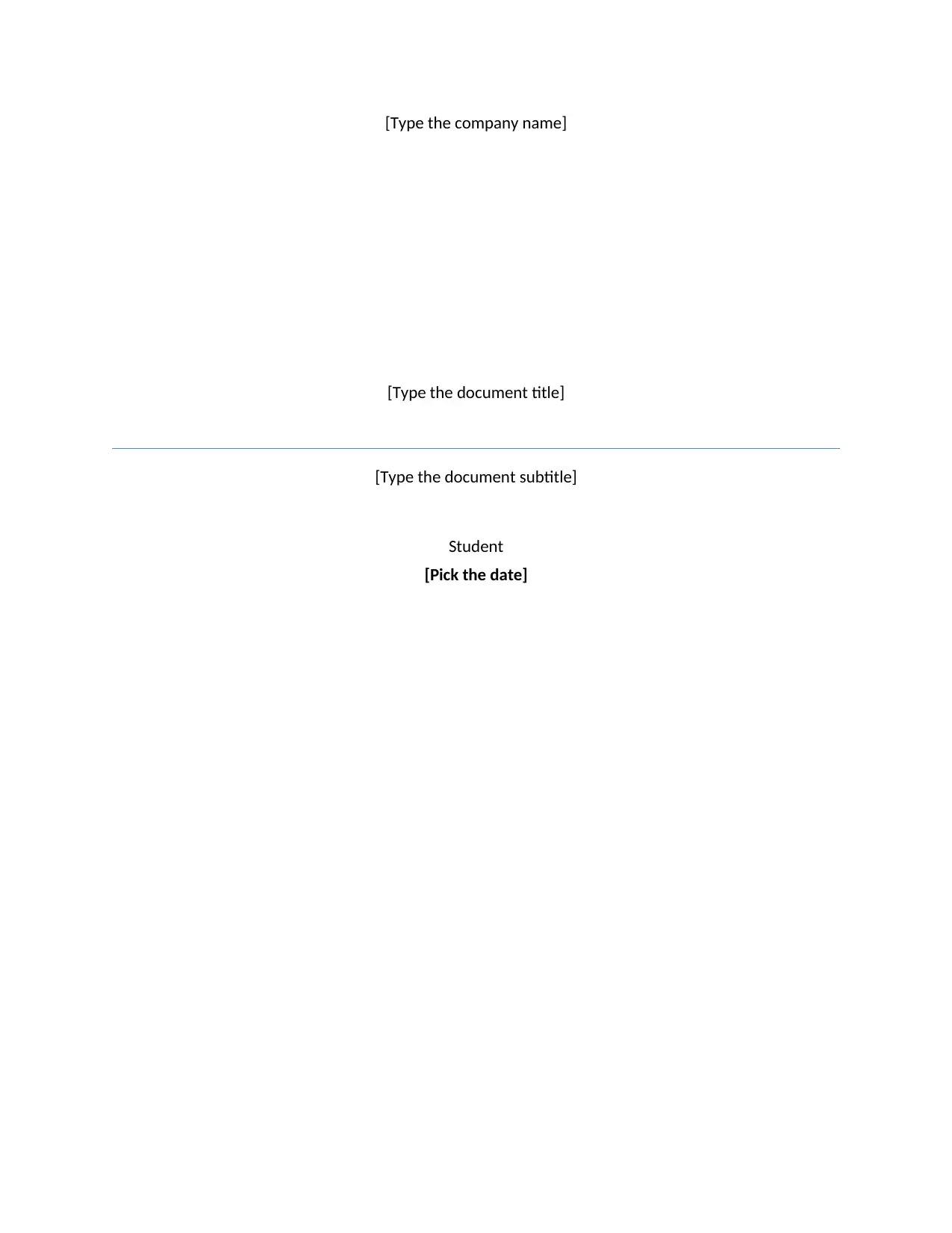
[Type the company name]
[Type the document title]
[Type the document subtitle]
Student
[Pick the date]
[Type the document title]
[Type the document subtitle]
Student
[Pick the date]
Paraphrase This Document
Need a fresh take? Get an instant paraphrase of this document with our AI Paraphraser
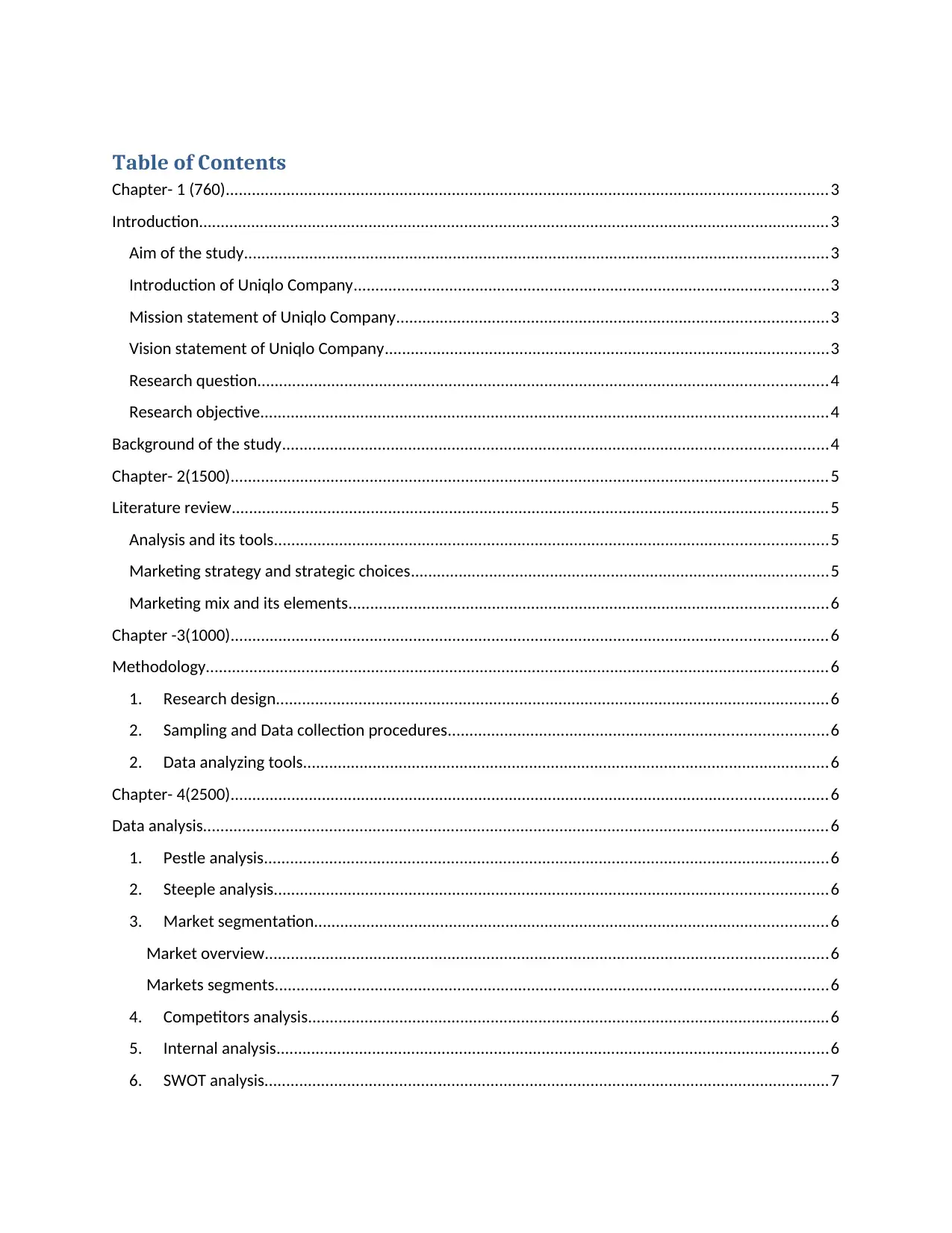
Table of Contents
Chapter- 1 (760)..........................................................................................................................................3
Introduction.................................................................................................................................................3
Aim of the study......................................................................................................................................3
Introduction of Uniqlo Company.............................................................................................................3
Mission statement of Uniqlo Company...................................................................................................3
Vision statement of Uniqlo Company......................................................................................................3
Research question...................................................................................................................................4
Research objective..................................................................................................................................4
Background of the study.............................................................................................................................4
Chapter- 2(1500).........................................................................................................................................5
Literature review.........................................................................................................................................5
Analysis and its tools...............................................................................................................................5
Marketing strategy and strategic choices................................................................................................5
Marketing mix and its elements..............................................................................................................6
Chapter -3(1000).........................................................................................................................................6
Methodology...............................................................................................................................................6
1. Research design...............................................................................................................................6
2. Sampling and Data collection procedures.......................................................................................6
2. Data analyzing tools.........................................................................................................................6
Chapter- 4(2500).........................................................................................................................................6
Data analysis................................................................................................................................................6
1. Pestle analysis..................................................................................................................................6
2. Steeple analysis...............................................................................................................................6
3. Market segmentation......................................................................................................................6
Market overview.................................................................................................................................6
Markets segments...............................................................................................................................6
4. Competitors analysis........................................................................................................................6
5. Internal analysis...............................................................................................................................6
6. SWOT analysis..................................................................................................................................7
Chapter- 1 (760)..........................................................................................................................................3
Introduction.................................................................................................................................................3
Aim of the study......................................................................................................................................3
Introduction of Uniqlo Company.............................................................................................................3
Mission statement of Uniqlo Company...................................................................................................3
Vision statement of Uniqlo Company......................................................................................................3
Research question...................................................................................................................................4
Research objective..................................................................................................................................4
Background of the study.............................................................................................................................4
Chapter- 2(1500).........................................................................................................................................5
Literature review.........................................................................................................................................5
Analysis and its tools...............................................................................................................................5
Marketing strategy and strategic choices................................................................................................5
Marketing mix and its elements..............................................................................................................6
Chapter -3(1000).........................................................................................................................................6
Methodology...............................................................................................................................................6
1. Research design...............................................................................................................................6
2. Sampling and Data collection procedures.......................................................................................6
2. Data analyzing tools.........................................................................................................................6
Chapter- 4(2500).........................................................................................................................................6
Data analysis................................................................................................................................................6
1. Pestle analysis..................................................................................................................................6
2. Steeple analysis...............................................................................................................................6
3. Market segmentation......................................................................................................................6
Market overview.................................................................................................................................6
Markets segments...............................................................................................................................6
4. Competitors analysis........................................................................................................................6
5. Internal analysis...............................................................................................................................6
6. SWOT analysis..................................................................................................................................7

Chapter- 5....................................................................................................................................................7
Findings.......................................................................................................................................................7
Competitive and growth strategy............................................................................................................7
Chapter-6.....................................................................................................................................................7
Recommendations (300).............................................................................................................................7
Conclusion...................................................................................................................................................7
References...................................................................................................................................................8
Findings.......................................................................................................................................................7
Competitive and growth strategy............................................................................................................7
Chapter-6.....................................................................................................................................................7
Recommendations (300).............................................................................................................................7
Conclusion...................................................................................................................................................7
References...................................................................................................................................................8
⊘ This is a preview!⊘
Do you want full access?
Subscribe today to unlock all pages.

Trusted by 1+ million students worldwide
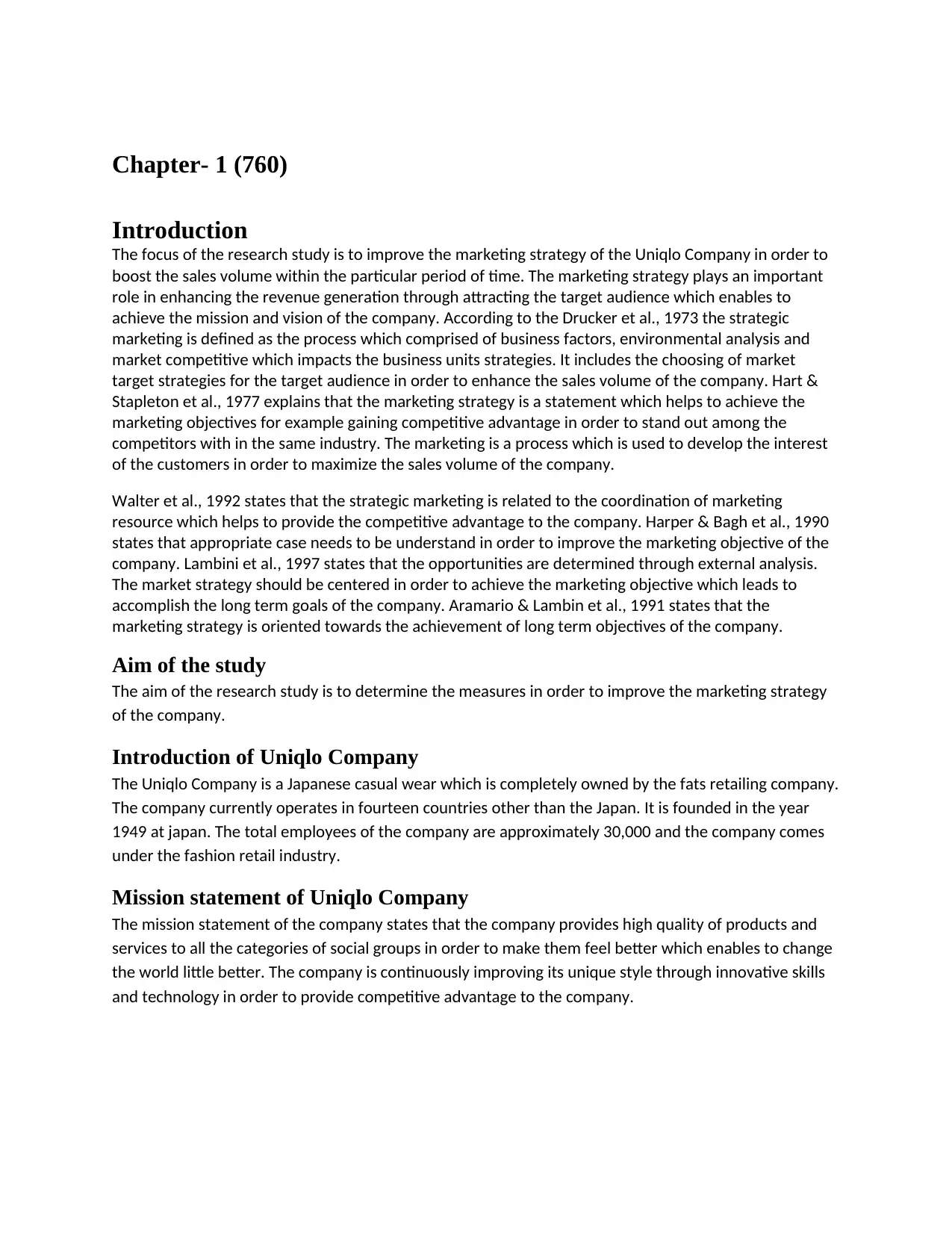
Chapter- 1 (760)
Introduction
The focus of the research study is to improve the marketing strategy of the Uniqlo Company in order to
boost the sales volume within the particular period of time. The marketing strategy plays an important
role in enhancing the revenue generation through attracting the target audience which enables to
achieve the mission and vision of the company. According to the Drucker et al., 1973 the strategic
marketing is defined as the process which comprised of business factors, environmental analysis and
market competitive which impacts the business units strategies. It includes the choosing of market
target strategies for the target audience in order to enhance the sales volume of the company. Hart &
Stapleton et al., 1977 explains that the marketing strategy is a statement which helps to achieve the
marketing objectives for example gaining competitive advantage in order to stand out among the
competitors with in the same industry. The marketing is a process which is used to develop the interest
of the customers in order to maximize the sales volume of the company.
Walter et al., 1992 states that the strategic marketing is related to the coordination of marketing
resource which helps to provide the competitive advantage to the company. Harper & Bagh et al., 1990
states that appropriate case needs to be understand in order to improve the marketing objective of the
company. Lambini et al., 1997 states that the opportunities are determined through external analysis.
The market strategy should be centered in order to achieve the marketing objective which leads to
accomplish the long term goals of the company. Aramario & Lambin et al., 1991 states that the
marketing strategy is oriented towards the achievement of long term objectives of the company.
Aim of the study
The aim of the research study is to determine the measures in order to improve the marketing strategy
of the company.
Introduction of Uniqlo Company
The Uniqlo Company is a Japanese casual wear which is completely owned by the fats retailing company.
The company currently operates in fourteen countries other than the Japan. It is founded in the year
1949 at japan. The total employees of the company are approximately 30,000 and the company comes
under the fashion retail industry.
Mission statement of Uniqlo Company
The mission statement of the company states that the company provides high quality of products and
services to all the categories of social groups in order to make them feel better which enables to change
the world little better. The company is continuously improving its unique style through innovative skills
and technology in order to provide competitive advantage to the company.
Introduction
The focus of the research study is to improve the marketing strategy of the Uniqlo Company in order to
boost the sales volume within the particular period of time. The marketing strategy plays an important
role in enhancing the revenue generation through attracting the target audience which enables to
achieve the mission and vision of the company. According to the Drucker et al., 1973 the strategic
marketing is defined as the process which comprised of business factors, environmental analysis and
market competitive which impacts the business units strategies. It includes the choosing of market
target strategies for the target audience in order to enhance the sales volume of the company. Hart &
Stapleton et al., 1977 explains that the marketing strategy is a statement which helps to achieve the
marketing objectives for example gaining competitive advantage in order to stand out among the
competitors with in the same industry. The marketing is a process which is used to develop the interest
of the customers in order to maximize the sales volume of the company.
Walter et al., 1992 states that the strategic marketing is related to the coordination of marketing
resource which helps to provide the competitive advantage to the company. Harper & Bagh et al., 1990
states that appropriate case needs to be understand in order to improve the marketing objective of the
company. Lambini et al., 1997 states that the opportunities are determined through external analysis.
The market strategy should be centered in order to achieve the marketing objective which leads to
accomplish the long term goals of the company. Aramario & Lambin et al., 1991 states that the
marketing strategy is oriented towards the achievement of long term objectives of the company.
Aim of the study
The aim of the research study is to determine the measures in order to improve the marketing strategy
of the company.
Introduction of Uniqlo Company
The Uniqlo Company is a Japanese casual wear which is completely owned by the fats retailing company.
The company currently operates in fourteen countries other than the Japan. It is founded in the year
1949 at japan. The total employees of the company are approximately 30,000 and the company comes
under the fashion retail industry.
Mission statement of Uniqlo Company
The mission statement of the company states that the company provides high quality of products and
services to all the categories of social groups in order to make them feel better which enables to change
the world little better. The company is continuously improving its unique style through innovative skills
and technology in order to provide competitive advantage to the company.
Paraphrase This Document
Need a fresh take? Get an instant paraphrase of this document with our AI Paraphraser
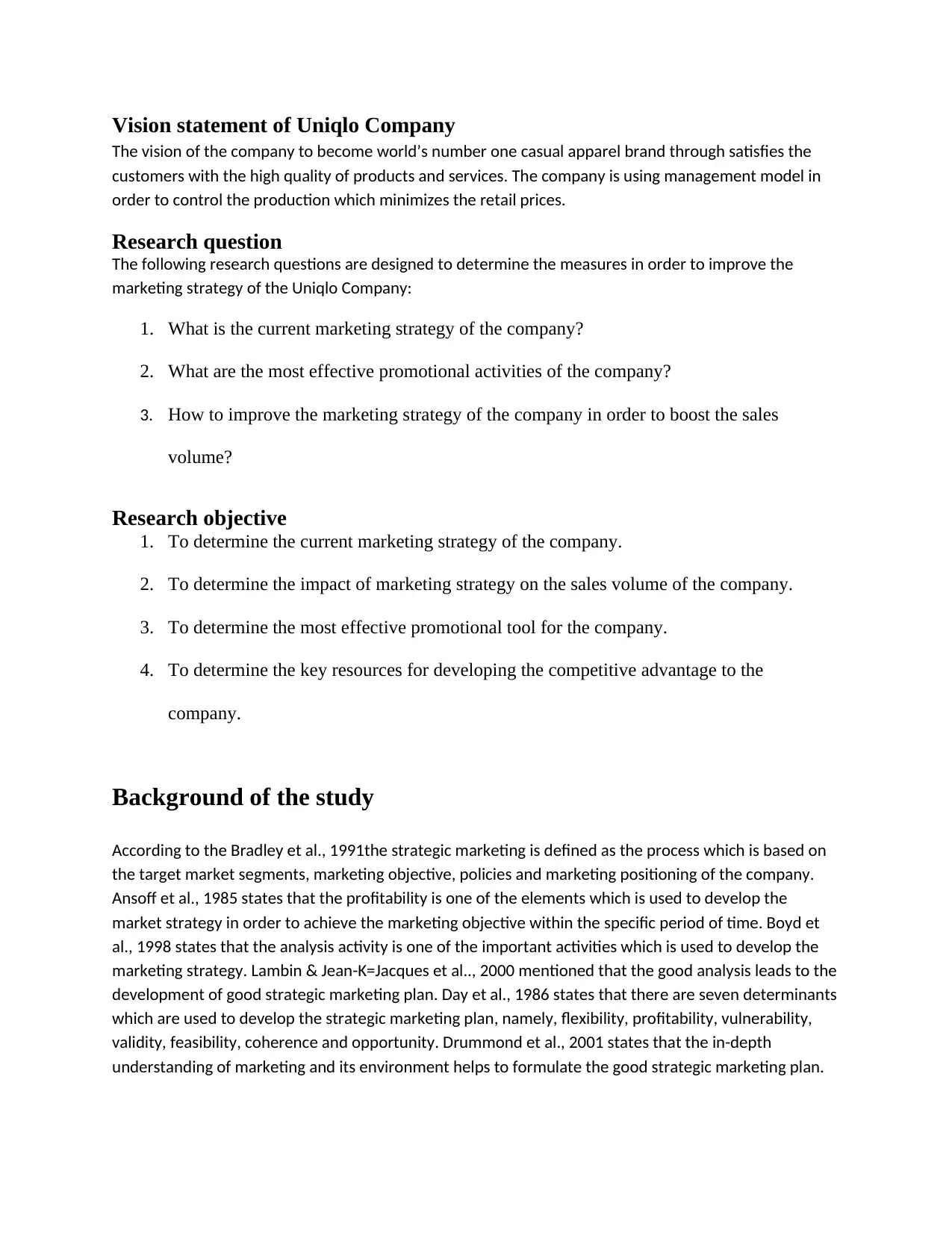
Vision statement of Uniqlo Company
The vision of the company to become world’s number one casual apparel brand through satisfies the
customers with the high quality of products and services. The company is using management model in
order to control the production which minimizes the retail prices.
Research question
The following research questions are designed to determine the measures in order to improve the
marketing strategy of the Uniqlo Company:
1. What is the current marketing strategy of the company?
2. What are the most effective promotional activities of the company?
3. How to improve the marketing strategy of the company in order to boost the sales
volume?
Research objective
1. To determine the current marketing strategy of the company.
2. To determine the impact of marketing strategy on the sales volume of the company.
3. To determine the most effective promotional tool for the company.
4. To determine the key resources for developing the competitive advantage to the
company.
Background of the study
According to the Bradley et al., 1991the strategic marketing is defined as the process which is based on
the target market segments, marketing objective, policies and marketing positioning of the company.
Ansoff et al., 1985 states that the profitability is one of the elements which is used to develop the
market strategy in order to achieve the marketing objective within the specific period of time. Boyd et
al., 1998 states that the analysis activity is one of the important activities which is used to develop the
marketing strategy. Lambin & Jean-K=Jacques et al.., 2000 mentioned that the good analysis leads to the
development of good strategic marketing plan. Day et al., 1986 states that there are seven determinants
which are used to develop the strategic marketing plan, namely, flexibility, profitability, vulnerability,
validity, feasibility, coherence and opportunity. Drummond et al., 2001 states that the in-depth
understanding of marketing and its environment helps to formulate the good strategic marketing plan.
The vision of the company to become world’s number one casual apparel brand through satisfies the
customers with the high quality of products and services. The company is using management model in
order to control the production which minimizes the retail prices.
Research question
The following research questions are designed to determine the measures in order to improve the
marketing strategy of the Uniqlo Company:
1. What is the current marketing strategy of the company?
2. What are the most effective promotional activities of the company?
3. How to improve the marketing strategy of the company in order to boost the sales
volume?
Research objective
1. To determine the current marketing strategy of the company.
2. To determine the impact of marketing strategy on the sales volume of the company.
3. To determine the most effective promotional tool for the company.
4. To determine the key resources for developing the competitive advantage to the
company.
Background of the study
According to the Bradley et al., 1991the strategic marketing is defined as the process which is based on
the target market segments, marketing objective, policies and marketing positioning of the company.
Ansoff et al., 1985 states that the profitability is one of the elements which is used to develop the
market strategy in order to achieve the marketing objective within the specific period of time. Boyd et
al., 1998 states that the analysis activity is one of the important activities which is used to develop the
marketing strategy. Lambin & Jean-K=Jacques et al.., 2000 mentioned that the good analysis leads to the
development of good strategic marketing plan. Day et al., 1986 states that there are seven determinants
which are used to develop the strategic marketing plan, namely, flexibility, profitability, vulnerability,
validity, feasibility, coherence and opportunity. Drummond et al., 2001 states that the in-depth
understanding of marketing and its environment helps to formulate the good strategic marketing plan.
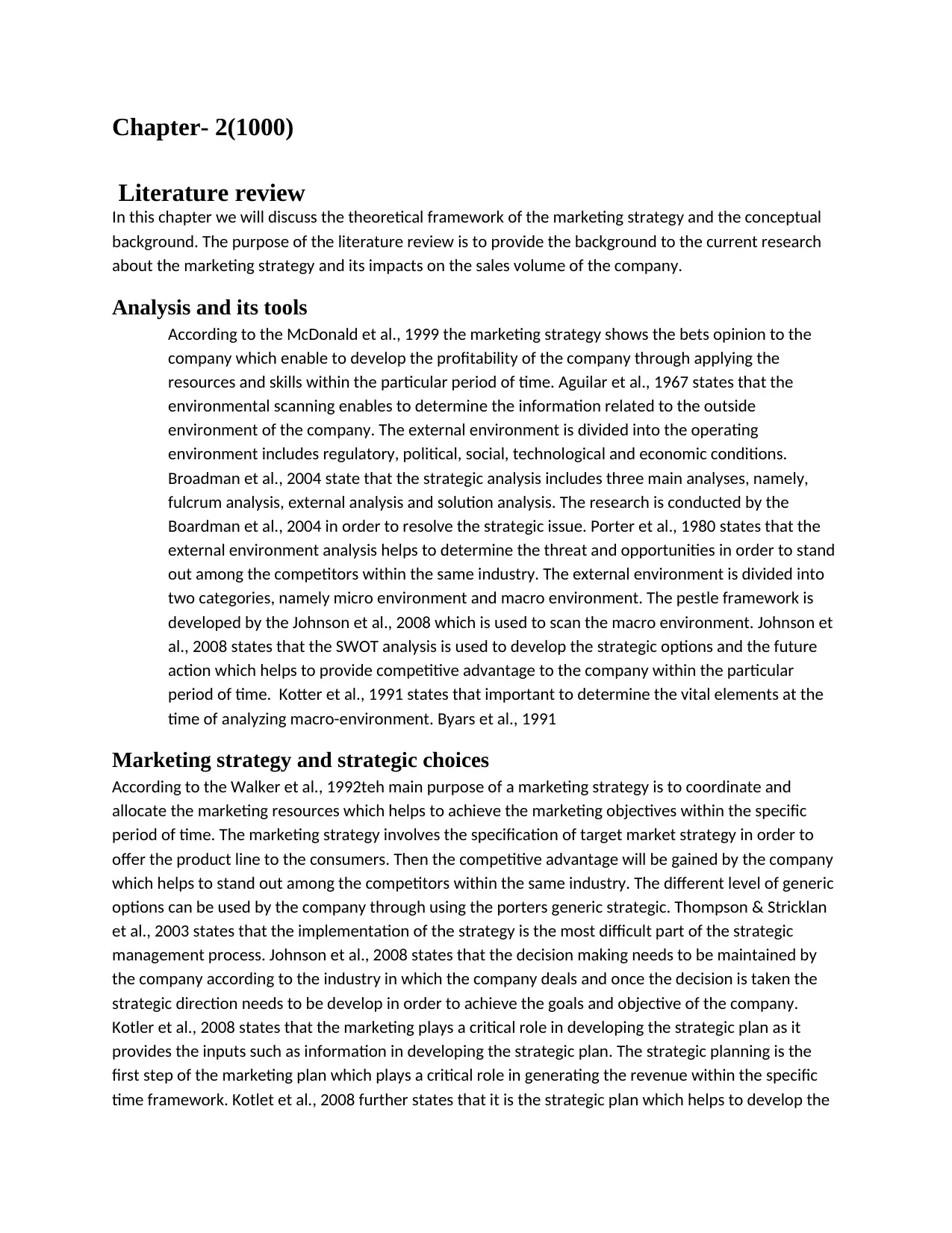
Chapter- 2(1000)
Literature review
In this chapter we will discuss the theoretical framework of the marketing strategy and the conceptual
background. The purpose of the literature review is to provide the background to the current research
about the marketing strategy and its impacts on the sales volume of the company.
Analysis and its tools
According to the McDonald et al., 1999 the marketing strategy shows the bets opinion to the
company which enable to develop the profitability of the company through applying the
resources and skills within the particular period of time. Aguilar et al., 1967 states that the
environmental scanning enables to determine the information related to the outside
environment of the company. The external environment is divided into the operating
environment includes regulatory, political, social, technological and economic conditions.
Broadman et al., 2004 state that the strategic analysis includes three main analyses, namely,
fulcrum analysis, external analysis and solution analysis. The research is conducted by the
Boardman et al., 2004 in order to resolve the strategic issue. Porter et al., 1980 states that the
external environment analysis helps to determine the threat and opportunities in order to stand
out among the competitors within the same industry. The external environment is divided into
two categories, namely micro environment and macro environment. The pestle framework is
developed by the Johnson et al., 2008 which is used to scan the macro environment. Johnson et
al., 2008 states that the SWOT analysis is used to develop the strategic options and the future
action which helps to provide competitive advantage to the company within the particular
period of time. Kotter et al., 1991 states that important to determine the vital elements at the
time of analyzing macro-environment. Byars et al., 1991
Marketing strategy and strategic choices
According to the Walker et al., 1992teh main purpose of a marketing strategy is to coordinate and
allocate the marketing resources which helps to achieve the marketing objectives within the specific
period of time. The marketing strategy involves the specification of target market strategy in order to
offer the product line to the consumers. Then the competitive advantage will be gained by the company
which helps to stand out among the competitors within the same industry. The different level of generic
options can be used by the company through using the porters generic strategic. Thompson & Stricklan
et al., 2003 states that the implementation of the strategy is the most difficult part of the strategic
management process. Johnson et al., 2008 states that the decision making needs to be maintained by
the company according to the industry in which the company deals and once the decision is taken the
strategic direction needs to be develop in order to achieve the goals and objective of the company.
Kotler et al., 2008 states that the marketing plays a critical role in developing the strategic plan as it
provides the inputs such as information in developing the strategic plan. The strategic planning is the
first step of the marketing plan which plays a critical role in generating the revenue within the specific
time framework. Kotlet et al., 2008 further states that it is the strategic plan which helps to develop the
Literature review
In this chapter we will discuss the theoretical framework of the marketing strategy and the conceptual
background. The purpose of the literature review is to provide the background to the current research
about the marketing strategy and its impacts on the sales volume of the company.
Analysis and its tools
According to the McDonald et al., 1999 the marketing strategy shows the bets opinion to the
company which enable to develop the profitability of the company through applying the
resources and skills within the particular period of time. Aguilar et al., 1967 states that the
environmental scanning enables to determine the information related to the outside
environment of the company. The external environment is divided into the operating
environment includes regulatory, political, social, technological and economic conditions.
Broadman et al., 2004 state that the strategic analysis includes three main analyses, namely,
fulcrum analysis, external analysis and solution analysis. The research is conducted by the
Boardman et al., 2004 in order to resolve the strategic issue. Porter et al., 1980 states that the
external environment analysis helps to determine the threat and opportunities in order to stand
out among the competitors within the same industry. The external environment is divided into
two categories, namely micro environment and macro environment. The pestle framework is
developed by the Johnson et al., 2008 which is used to scan the macro environment. Johnson et
al., 2008 states that the SWOT analysis is used to develop the strategic options and the future
action which helps to provide competitive advantage to the company within the particular
period of time. Kotter et al., 1991 states that important to determine the vital elements at the
time of analyzing macro-environment. Byars et al., 1991
Marketing strategy and strategic choices
According to the Walker et al., 1992teh main purpose of a marketing strategy is to coordinate and
allocate the marketing resources which helps to achieve the marketing objectives within the specific
period of time. The marketing strategy involves the specification of target market strategy in order to
offer the product line to the consumers. Then the competitive advantage will be gained by the company
which helps to stand out among the competitors within the same industry. The different level of generic
options can be used by the company through using the porters generic strategic. Thompson & Stricklan
et al., 2003 states that the implementation of the strategy is the most difficult part of the strategic
management process. Johnson et al., 2008 states that the decision making needs to be maintained by
the company according to the industry in which the company deals and once the decision is taken the
strategic direction needs to be develop in order to achieve the goals and objective of the company.
Kotler et al., 2008 states that the marketing plays a critical role in developing the strategic plan as it
provides the inputs such as information in developing the strategic plan. The strategic planning is the
first step of the marketing plan which plays a critical role in generating the revenue within the specific
time framework. Kotlet et al., 2008 further states that it is the strategic plan which helps to develop the
⊘ This is a preview!⊘
Do you want full access?
Subscribe today to unlock all pages.

Trusted by 1+ million students worldwide
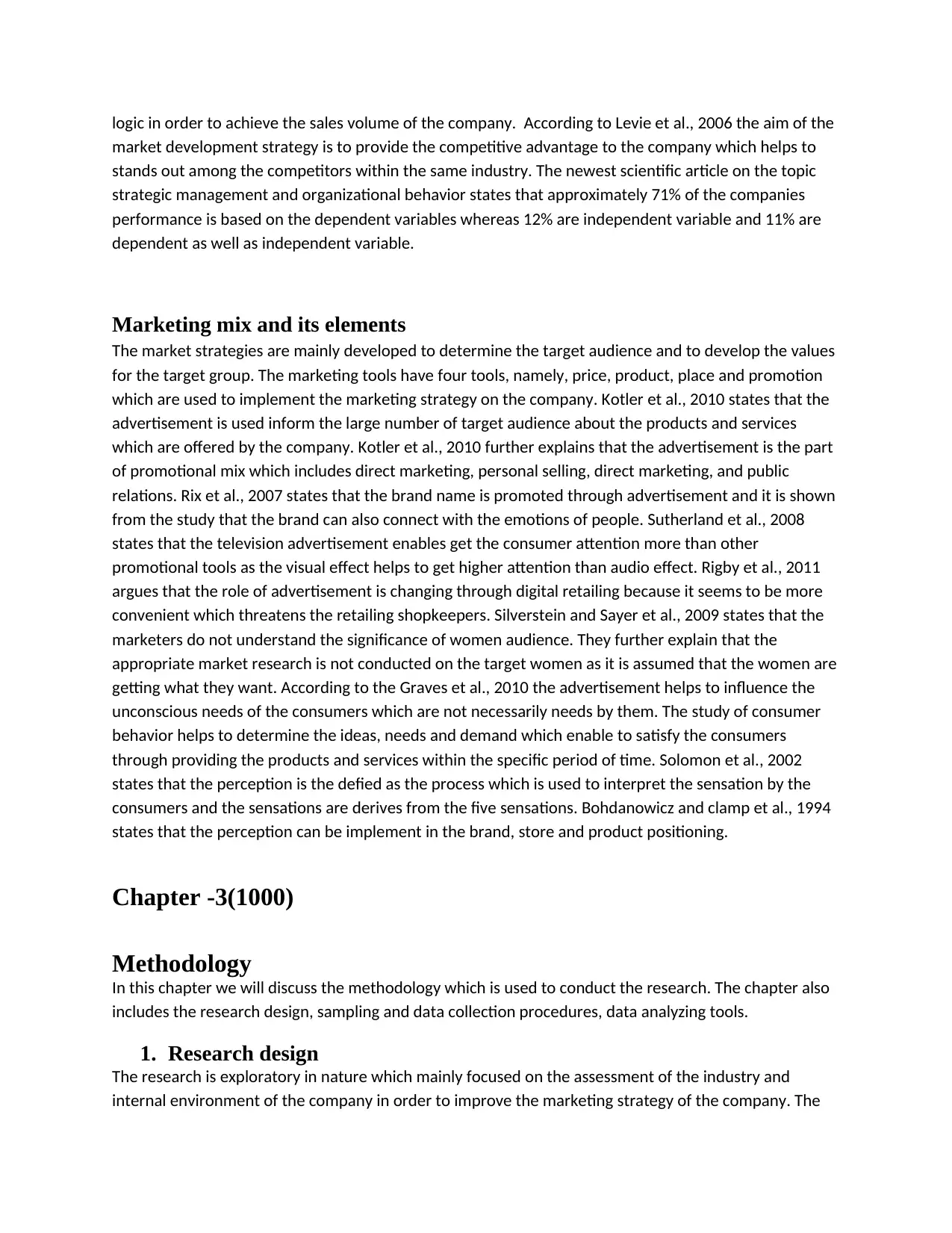
logic in order to achieve the sales volume of the company. According to Levie et al., 2006 the aim of the
market development strategy is to provide the competitive advantage to the company which helps to
stands out among the competitors within the same industry. The newest scientific article on the topic
strategic management and organizational behavior states that approximately 71% of the companies
performance is based on the dependent variables whereas 12% are independent variable and 11% are
dependent as well as independent variable.
Marketing mix and its elements
The market strategies are mainly developed to determine the target audience and to develop the values
for the target group. The marketing tools have four tools, namely, price, product, place and promotion
which are used to implement the marketing strategy on the company. Kotler et al., 2010 states that the
advertisement is used inform the large number of target audience about the products and services
which are offered by the company. Kotler et al., 2010 further explains that the advertisement is the part
of promotional mix which includes direct marketing, personal selling, direct marketing, and public
relations. Rix et al., 2007 states that the brand name is promoted through advertisement and it is shown
from the study that the brand can also connect with the emotions of people. Sutherland et al., 2008
states that the television advertisement enables get the consumer attention more than other
promotional tools as the visual effect helps to get higher attention than audio effect. Rigby et al., 2011
argues that the role of advertisement is changing through digital retailing because it seems to be more
convenient which threatens the retailing shopkeepers. Silverstein and Sayer et al., 2009 states that the
marketers do not understand the significance of women audience. They further explain that the
appropriate market research is not conducted on the target women as it is assumed that the women are
getting what they want. According to the Graves et al., 2010 the advertisement helps to influence the
unconscious needs of the consumers which are not necessarily needs by them. The study of consumer
behavior helps to determine the ideas, needs and demand which enable to satisfy the consumers
through providing the products and services within the specific period of time. Solomon et al., 2002
states that the perception is the defied as the process which is used to interpret the sensation by the
consumers and the sensations are derives from the five sensations. Bohdanowicz and clamp et al., 1994
states that the perception can be implement in the brand, store and product positioning.
Chapter -3(1000)
Methodology
In this chapter we will discuss the methodology which is used to conduct the research. The chapter also
includes the research design, sampling and data collection procedures, data analyzing tools.
1. Research design
The research is exploratory in nature which mainly focused on the assessment of the industry and
internal environment of the company in order to improve the marketing strategy of the company. The
market development strategy is to provide the competitive advantage to the company which helps to
stands out among the competitors within the same industry. The newest scientific article on the topic
strategic management and organizational behavior states that approximately 71% of the companies
performance is based on the dependent variables whereas 12% are independent variable and 11% are
dependent as well as independent variable.
Marketing mix and its elements
The market strategies are mainly developed to determine the target audience and to develop the values
for the target group. The marketing tools have four tools, namely, price, product, place and promotion
which are used to implement the marketing strategy on the company. Kotler et al., 2010 states that the
advertisement is used inform the large number of target audience about the products and services
which are offered by the company. Kotler et al., 2010 further explains that the advertisement is the part
of promotional mix which includes direct marketing, personal selling, direct marketing, and public
relations. Rix et al., 2007 states that the brand name is promoted through advertisement and it is shown
from the study that the brand can also connect with the emotions of people. Sutherland et al., 2008
states that the television advertisement enables get the consumer attention more than other
promotional tools as the visual effect helps to get higher attention than audio effect. Rigby et al., 2011
argues that the role of advertisement is changing through digital retailing because it seems to be more
convenient which threatens the retailing shopkeepers. Silverstein and Sayer et al., 2009 states that the
marketers do not understand the significance of women audience. They further explain that the
appropriate market research is not conducted on the target women as it is assumed that the women are
getting what they want. According to the Graves et al., 2010 the advertisement helps to influence the
unconscious needs of the consumers which are not necessarily needs by them. The study of consumer
behavior helps to determine the ideas, needs and demand which enable to satisfy the consumers
through providing the products and services within the specific period of time. Solomon et al., 2002
states that the perception is the defied as the process which is used to interpret the sensation by the
consumers and the sensations are derives from the five sensations. Bohdanowicz and clamp et al., 1994
states that the perception can be implement in the brand, store and product positioning.
Chapter -3(1000)
Methodology
In this chapter we will discuss the methodology which is used to conduct the research. The chapter also
includes the research design, sampling and data collection procedures, data analyzing tools.
1. Research design
The research is exploratory in nature which mainly focused on the assessment of the industry and
internal environment of the company in order to improve the marketing strategy of the company. The
Paraphrase This Document
Need a fresh take? Get an instant paraphrase of this document with our AI Paraphraser
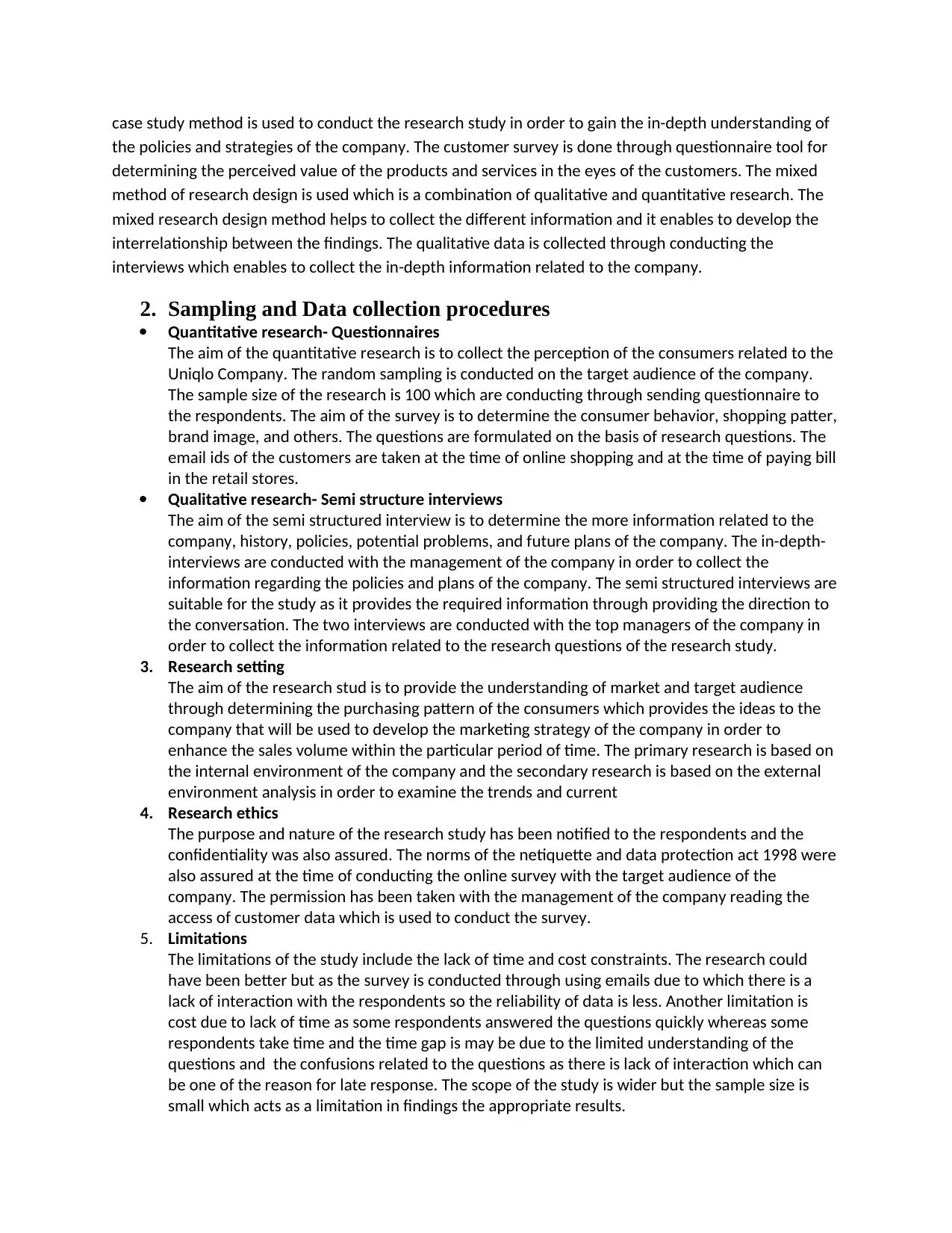
case study method is used to conduct the research study in order to gain the in-depth understanding of
the policies and strategies of the company. The customer survey is done through questionnaire tool for
determining the perceived value of the products and services in the eyes of the customers. The mixed
method of research design is used which is a combination of qualitative and quantitative research. The
mixed research design method helps to collect the different information and it enables to develop the
interrelationship between the findings. The qualitative data is collected through conducting the
interviews which enables to collect the in-depth information related to the company.
2. Sampling and Data collection procedures
Quantitative research- Questionnaires
The aim of the quantitative research is to collect the perception of the consumers related to the
Uniqlo Company. The random sampling is conducted on the target audience of the company.
The sample size of the research is 100 which are conducting through sending questionnaire to
the respondents. The aim of the survey is to determine the consumer behavior, shopping patter,
brand image, and others. The questions are formulated on the basis of research questions. The
email ids of the customers are taken at the time of online shopping and at the time of paying bill
in the retail stores.
Qualitative research- Semi structure interviews
The aim of the semi structured interview is to determine the more information related to the
company, history, policies, potential problems, and future plans of the company. The in-depth-
interviews are conducted with the management of the company in order to collect the
information regarding the policies and plans of the company. The semi structured interviews are
suitable for the study as it provides the required information through providing the direction to
the conversation. The two interviews are conducted with the top managers of the company in
order to collect the information related to the research questions of the research study.
3. Research setting
The aim of the research stud is to provide the understanding of market and target audience
through determining the purchasing pattern of the consumers which provides the ideas to the
company that will be used to develop the marketing strategy of the company in order to
enhance the sales volume within the particular period of time. The primary research is based on
the internal environment of the company and the secondary research is based on the external
environment analysis in order to examine the trends and current
4. Research ethics
The purpose and nature of the research study has been notified to the respondents and the
confidentiality was also assured. The norms of the netiquette and data protection act 1998 were
also assured at the time of conducting the online survey with the target audience of the
company. The permission has been taken with the management of the company reading the
access of customer data which is used to conduct the survey.
5. Limitations
The limitations of the study include the lack of time and cost constraints. The research could
have been better but as the survey is conducted through using emails due to which there is a
lack of interaction with the respondents so the reliability of data is less. Another limitation is
cost due to lack of time as some respondents answered the questions quickly whereas some
respondents take time and the time gap is may be due to the limited understanding of the
questions and the confusions related to the questions as there is lack of interaction which can
be one of the reason for late response. The scope of the study is wider but the sample size is
small which acts as a limitation in findings the appropriate results.
the policies and strategies of the company. The customer survey is done through questionnaire tool for
determining the perceived value of the products and services in the eyes of the customers. The mixed
method of research design is used which is a combination of qualitative and quantitative research. The
mixed research design method helps to collect the different information and it enables to develop the
interrelationship between the findings. The qualitative data is collected through conducting the
interviews which enables to collect the in-depth information related to the company.
2. Sampling and Data collection procedures
Quantitative research- Questionnaires
The aim of the quantitative research is to collect the perception of the consumers related to the
Uniqlo Company. The random sampling is conducted on the target audience of the company.
The sample size of the research is 100 which are conducting through sending questionnaire to
the respondents. The aim of the survey is to determine the consumer behavior, shopping patter,
brand image, and others. The questions are formulated on the basis of research questions. The
email ids of the customers are taken at the time of online shopping and at the time of paying bill
in the retail stores.
Qualitative research- Semi structure interviews
The aim of the semi structured interview is to determine the more information related to the
company, history, policies, potential problems, and future plans of the company. The in-depth-
interviews are conducted with the management of the company in order to collect the
information regarding the policies and plans of the company. The semi structured interviews are
suitable for the study as it provides the required information through providing the direction to
the conversation. The two interviews are conducted with the top managers of the company in
order to collect the information related to the research questions of the research study.
3. Research setting
The aim of the research stud is to provide the understanding of market and target audience
through determining the purchasing pattern of the consumers which provides the ideas to the
company that will be used to develop the marketing strategy of the company in order to
enhance the sales volume within the particular period of time. The primary research is based on
the internal environment of the company and the secondary research is based on the external
environment analysis in order to examine the trends and current
4. Research ethics
The purpose and nature of the research study has been notified to the respondents and the
confidentiality was also assured. The norms of the netiquette and data protection act 1998 were
also assured at the time of conducting the online survey with the target audience of the
company. The permission has been taken with the management of the company reading the
access of customer data which is used to conduct the survey.
5. Limitations
The limitations of the study include the lack of time and cost constraints. The research could
have been better but as the survey is conducted through using emails due to which there is a
lack of interaction with the respondents so the reliability of data is less. Another limitation is
cost due to lack of time as some respondents answered the questions quickly whereas some
respondents take time and the time gap is may be due to the limited understanding of the
questions and the confusions related to the questions as there is lack of interaction which can
be one of the reason for late response. The scope of the study is wider but the sample size is
small which acts as a limitation in findings the appropriate results.
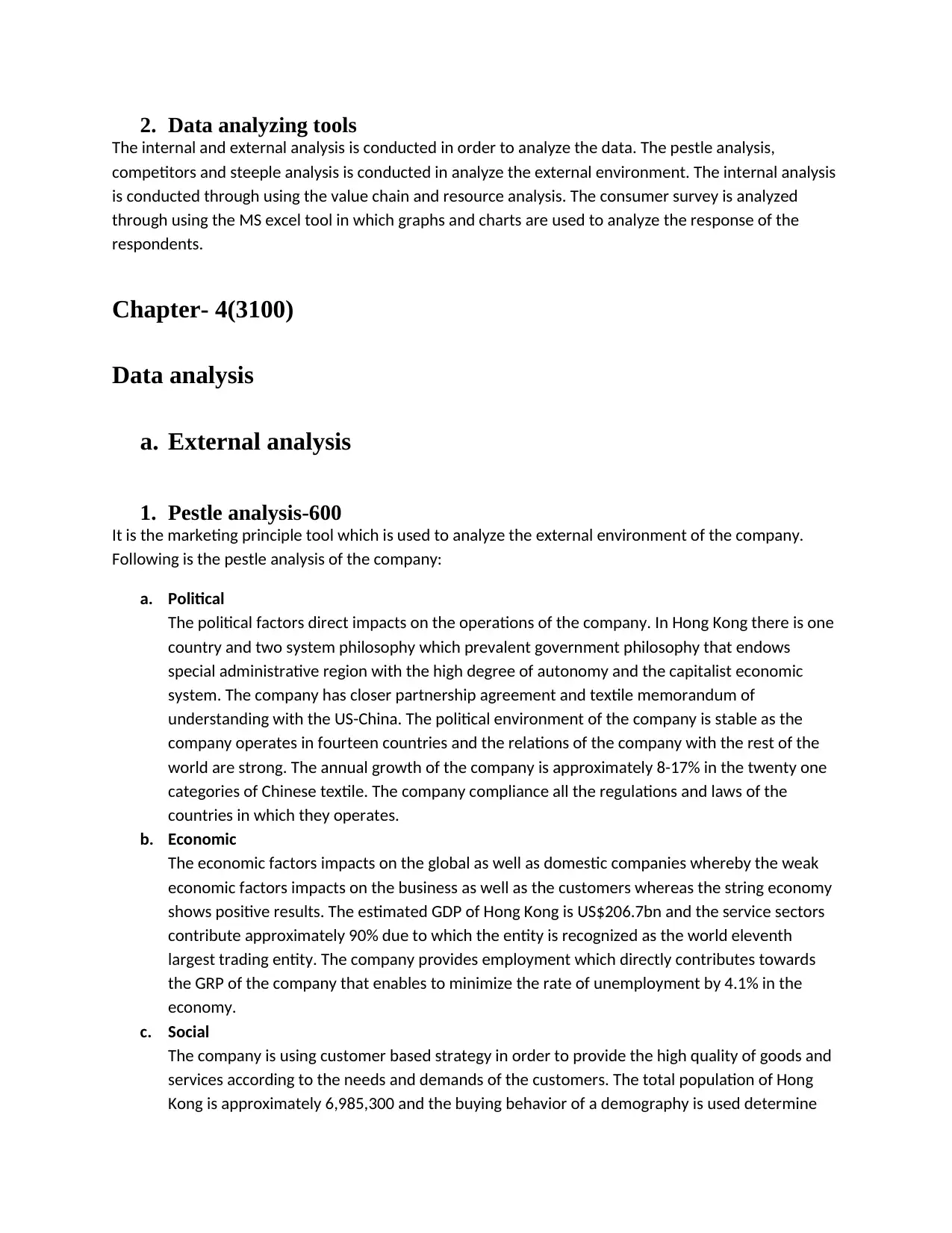
2. Data analyzing tools
The internal and external analysis is conducted in order to analyze the data. The pestle analysis,
competitors and steeple analysis is conducted in analyze the external environment. The internal analysis
is conducted through using the value chain and resource analysis. The consumer survey is analyzed
through using the MS excel tool in which graphs and charts are used to analyze the response of the
respondents.
Chapter- 4(3100)
Data analysis
a. External analysis
1. Pestle analysis-600
It is the marketing principle tool which is used to analyze the external environment of the company.
Following is the pestle analysis of the company:
a. Political
The political factors direct impacts on the operations of the company. In Hong Kong there is one
country and two system philosophy which prevalent government philosophy that endows
special administrative region with the high degree of autonomy and the capitalist economic
system. The company has closer partnership agreement and textile memorandum of
understanding with the US-China. The political environment of the company is stable as the
company operates in fourteen countries and the relations of the company with the rest of the
world are strong. The annual growth of the company is approximately 8-17% in the twenty one
categories of Chinese textile. The company compliance all the regulations and laws of the
countries in which they operates.
b. Economic
The economic factors impacts on the global as well as domestic companies whereby the weak
economic factors impacts on the business as well as the customers whereas the string economy
shows positive results. The estimated GDP of Hong Kong is US$206.7bn and the service sectors
contribute approximately 90% due to which the entity is recognized as the world eleventh
largest trading entity. The company provides employment which directly contributes towards
the GRP of the company that enables to minimize the rate of unemployment by 4.1% in the
economy.
c. Social
The company is using customer based strategy in order to provide the high quality of goods and
services according to the needs and demands of the customers. The total population of Hong
Kong is approximately 6,985,300 and the buying behavior of a demography is used determine
The internal and external analysis is conducted in order to analyze the data. The pestle analysis,
competitors and steeple analysis is conducted in analyze the external environment. The internal analysis
is conducted through using the value chain and resource analysis. The consumer survey is analyzed
through using the MS excel tool in which graphs and charts are used to analyze the response of the
respondents.
Chapter- 4(3100)
Data analysis
a. External analysis
1. Pestle analysis-600
It is the marketing principle tool which is used to analyze the external environment of the company.
Following is the pestle analysis of the company:
a. Political
The political factors direct impacts on the operations of the company. In Hong Kong there is one
country and two system philosophy which prevalent government philosophy that endows
special administrative region with the high degree of autonomy and the capitalist economic
system. The company has closer partnership agreement and textile memorandum of
understanding with the US-China. The political environment of the company is stable as the
company operates in fourteen countries and the relations of the company with the rest of the
world are strong. The annual growth of the company is approximately 8-17% in the twenty one
categories of Chinese textile. The company compliance all the regulations and laws of the
countries in which they operates.
b. Economic
The economic factors impacts on the global as well as domestic companies whereby the weak
economic factors impacts on the business as well as the customers whereas the string economy
shows positive results. The estimated GDP of Hong Kong is US$206.7bn and the service sectors
contribute approximately 90% due to which the entity is recognized as the world eleventh
largest trading entity. The company provides employment which directly contributes towards
the GRP of the company that enables to minimize the rate of unemployment by 4.1% in the
economy.
c. Social
The company is using customer based strategy in order to provide the high quality of goods and
services according to the needs and demands of the customers. The total population of Hong
Kong is approximately 6,985,300 and the buying behavior of a demography is used determine
⊘ This is a preview!⊘
Do you want full access?
Subscribe today to unlock all pages.

Trusted by 1+ million students worldwide
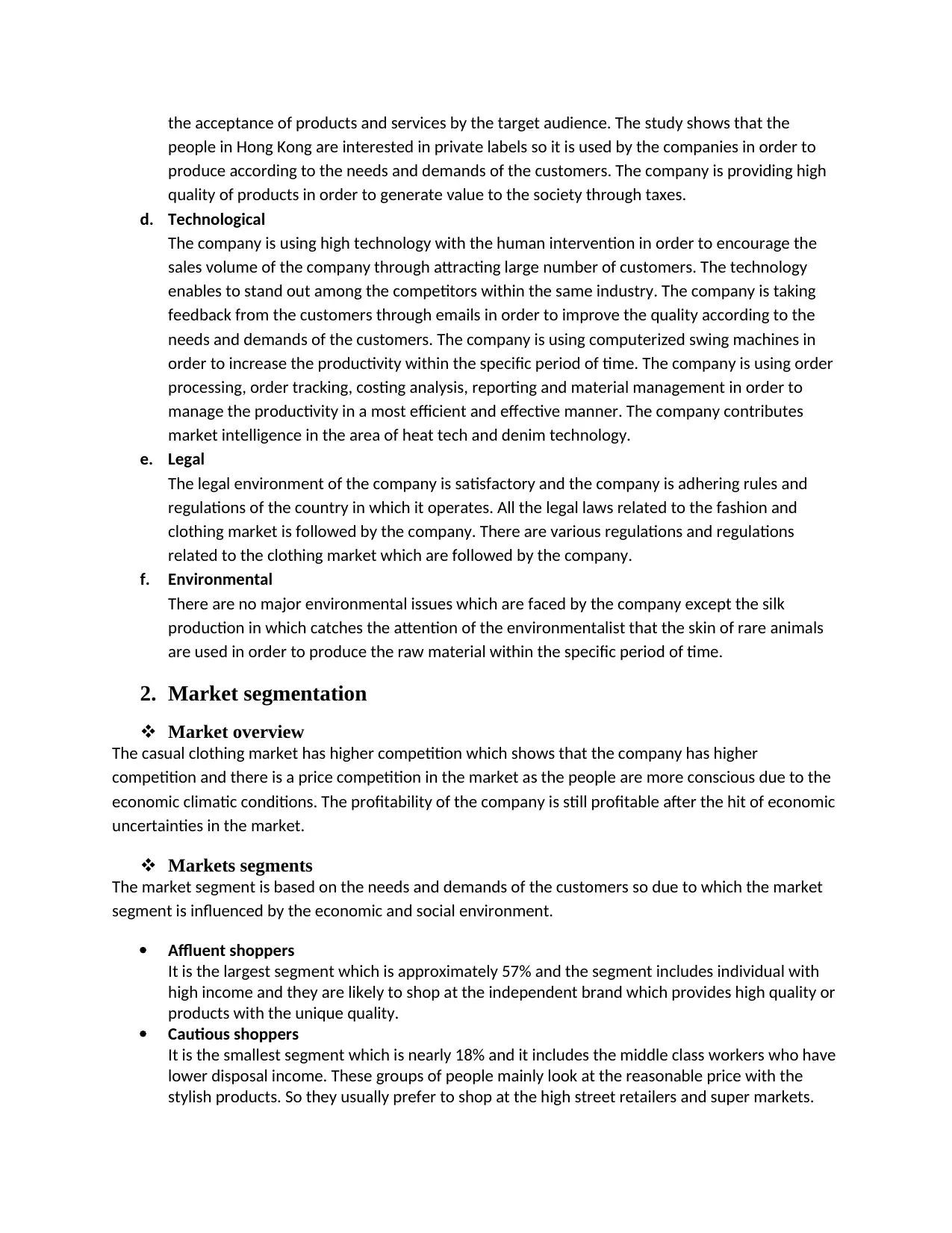
the acceptance of products and services by the target audience. The study shows that the
people in Hong Kong are interested in private labels so it is used by the companies in order to
produce according to the needs and demands of the customers. The company is providing high
quality of products in order to generate value to the society through taxes.
d. Technological
The company is using high technology with the human intervention in order to encourage the
sales volume of the company through attracting large number of customers. The technology
enables to stand out among the competitors within the same industry. The company is taking
feedback from the customers through emails in order to improve the quality according to the
needs and demands of the customers. The company is using computerized swing machines in
order to increase the productivity within the specific period of time. The company is using order
processing, order tracking, costing analysis, reporting and material management in order to
manage the productivity in a most efficient and effective manner. The company contributes
market intelligence in the area of heat tech and denim technology.
e. Legal
The legal environment of the company is satisfactory and the company is adhering rules and
regulations of the country in which it operates. All the legal laws related to the fashion and
clothing market is followed by the company. There are various regulations and regulations
related to the clothing market which are followed by the company.
f. Environmental
There are no major environmental issues which are faced by the company except the silk
production in which catches the attention of the environmentalist that the skin of rare animals
are used in order to produce the raw material within the specific period of time.
2. Market segmentation
Market overview
The casual clothing market has higher competition which shows that the company has higher
competition and there is a price competition in the market as the people are more conscious due to the
economic climatic conditions. The profitability of the company is still profitable after the hit of economic
uncertainties in the market.
Markets segments
The market segment is based on the needs and demands of the customers so due to which the market
segment is influenced by the economic and social environment.
Affluent shoppers
It is the largest segment which is approximately 57% and the segment includes individual with
high income and they are likely to shop at the independent brand which provides high quality or
products with the unique quality.
Cautious shoppers
It is the smallest segment which is nearly 18% and it includes the middle class workers who have
lower disposal income. These groups of people mainly look at the reasonable price with the
stylish products. So they usually prefer to shop at the high street retailers and super markets.
people in Hong Kong are interested in private labels so it is used by the companies in order to
produce according to the needs and demands of the customers. The company is providing high
quality of products in order to generate value to the society through taxes.
d. Technological
The company is using high technology with the human intervention in order to encourage the
sales volume of the company through attracting large number of customers. The technology
enables to stand out among the competitors within the same industry. The company is taking
feedback from the customers through emails in order to improve the quality according to the
needs and demands of the customers. The company is using computerized swing machines in
order to increase the productivity within the specific period of time. The company is using order
processing, order tracking, costing analysis, reporting and material management in order to
manage the productivity in a most efficient and effective manner. The company contributes
market intelligence in the area of heat tech and denim technology.
e. Legal
The legal environment of the company is satisfactory and the company is adhering rules and
regulations of the country in which it operates. All the legal laws related to the fashion and
clothing market is followed by the company. There are various regulations and regulations
related to the clothing market which are followed by the company.
f. Environmental
There are no major environmental issues which are faced by the company except the silk
production in which catches the attention of the environmentalist that the skin of rare animals
are used in order to produce the raw material within the specific period of time.
2. Market segmentation
Market overview
The casual clothing market has higher competition which shows that the company has higher
competition and there is a price competition in the market as the people are more conscious due to the
economic climatic conditions. The profitability of the company is still profitable after the hit of economic
uncertainties in the market.
Markets segments
The market segment is based on the needs and demands of the customers so due to which the market
segment is influenced by the economic and social environment.
Affluent shoppers
It is the largest segment which is approximately 57% and the segment includes individual with
high income and they are likely to shop at the independent brand which provides high quality or
products with the unique quality.
Cautious shoppers
It is the smallest segment which is nearly 18% and it includes the middle class workers who have
lower disposal income. These groups of people mainly look at the reasonable price with the
stylish products. So they usually prefer to shop at the high street retailers and super markets.
Paraphrase This Document
Need a fresh take? Get an instant paraphrase of this document with our AI Paraphraser
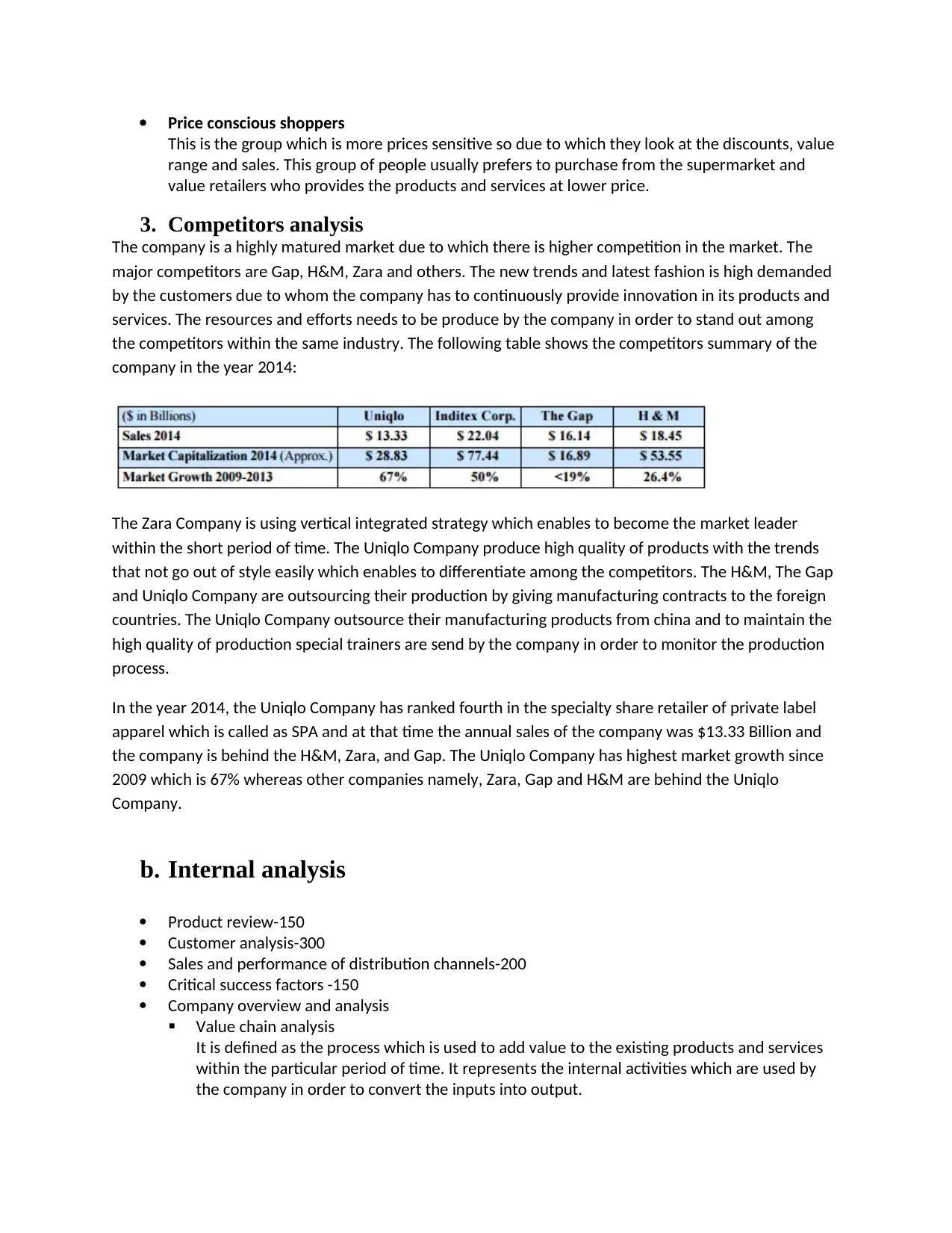
Price conscious shoppers
This is the group which is more prices sensitive so due to which they look at the discounts, value
range and sales. This group of people usually prefers to purchase from the supermarket and
value retailers who provides the products and services at lower price.
3. Competitors analysis
The company is a highly matured market due to which there is higher competition in the market. The
major competitors are Gap, H&M, Zara and others. The new trends and latest fashion is high demanded
by the customers due to whom the company has to continuously provide innovation in its products and
services. The resources and efforts needs to be produce by the company in order to stand out among
the competitors within the same industry. The following table shows the competitors summary of the
company in the year 2014:
The Zara Company is using vertical integrated strategy which enables to become the market leader
within the short period of time. The Uniqlo Company produce high quality of products with the trends
that not go out of style easily which enables to differentiate among the competitors. The H&M, The Gap
and Uniqlo Company are outsourcing their production by giving manufacturing contracts to the foreign
countries. The Uniqlo Company outsource their manufacturing products from china and to maintain the
high quality of production special trainers are send by the company in order to monitor the production
process.
In the year 2014, the Uniqlo Company has ranked fourth in the specialty share retailer of private label
apparel which is called as SPA and at that time the annual sales of the company was $13.33 Billion and
the company is behind the H&M, Zara, and Gap. The Uniqlo Company has highest market growth since
2009 which is 67% whereas other companies namely, Zara, Gap and H&M are behind the Uniqlo
Company.
b. Internal analysis
Product review-150
Customer analysis-300
Sales and performance of distribution channels-200
Critical success factors -150
Company overview and analysis
Value chain analysis
It is defined as the process which is used to add value to the existing products and services
within the particular period of time. It represents the internal activities which are used by
the company in order to convert the inputs into output.
This is the group which is more prices sensitive so due to which they look at the discounts, value
range and sales. This group of people usually prefers to purchase from the supermarket and
value retailers who provides the products and services at lower price.
3. Competitors analysis
The company is a highly matured market due to which there is higher competition in the market. The
major competitors are Gap, H&M, Zara and others. The new trends and latest fashion is high demanded
by the customers due to whom the company has to continuously provide innovation in its products and
services. The resources and efforts needs to be produce by the company in order to stand out among
the competitors within the same industry. The following table shows the competitors summary of the
company in the year 2014:
The Zara Company is using vertical integrated strategy which enables to become the market leader
within the short period of time. The Uniqlo Company produce high quality of products with the trends
that not go out of style easily which enables to differentiate among the competitors. The H&M, The Gap
and Uniqlo Company are outsourcing their production by giving manufacturing contracts to the foreign
countries. The Uniqlo Company outsource their manufacturing products from china and to maintain the
high quality of production special trainers are send by the company in order to monitor the production
process.
In the year 2014, the Uniqlo Company has ranked fourth in the specialty share retailer of private label
apparel which is called as SPA and at that time the annual sales of the company was $13.33 Billion and
the company is behind the H&M, Zara, and Gap. The Uniqlo Company has highest market growth since
2009 which is 67% whereas other companies namely, Zara, Gap and H&M are behind the Uniqlo
Company.
b. Internal analysis
Product review-150
Customer analysis-300
Sales and performance of distribution channels-200
Critical success factors -150
Company overview and analysis
Value chain analysis
It is defined as the process which is used to add value to the existing products and services
within the particular period of time. It represents the internal activities which are used by
the company in order to convert the inputs into output.
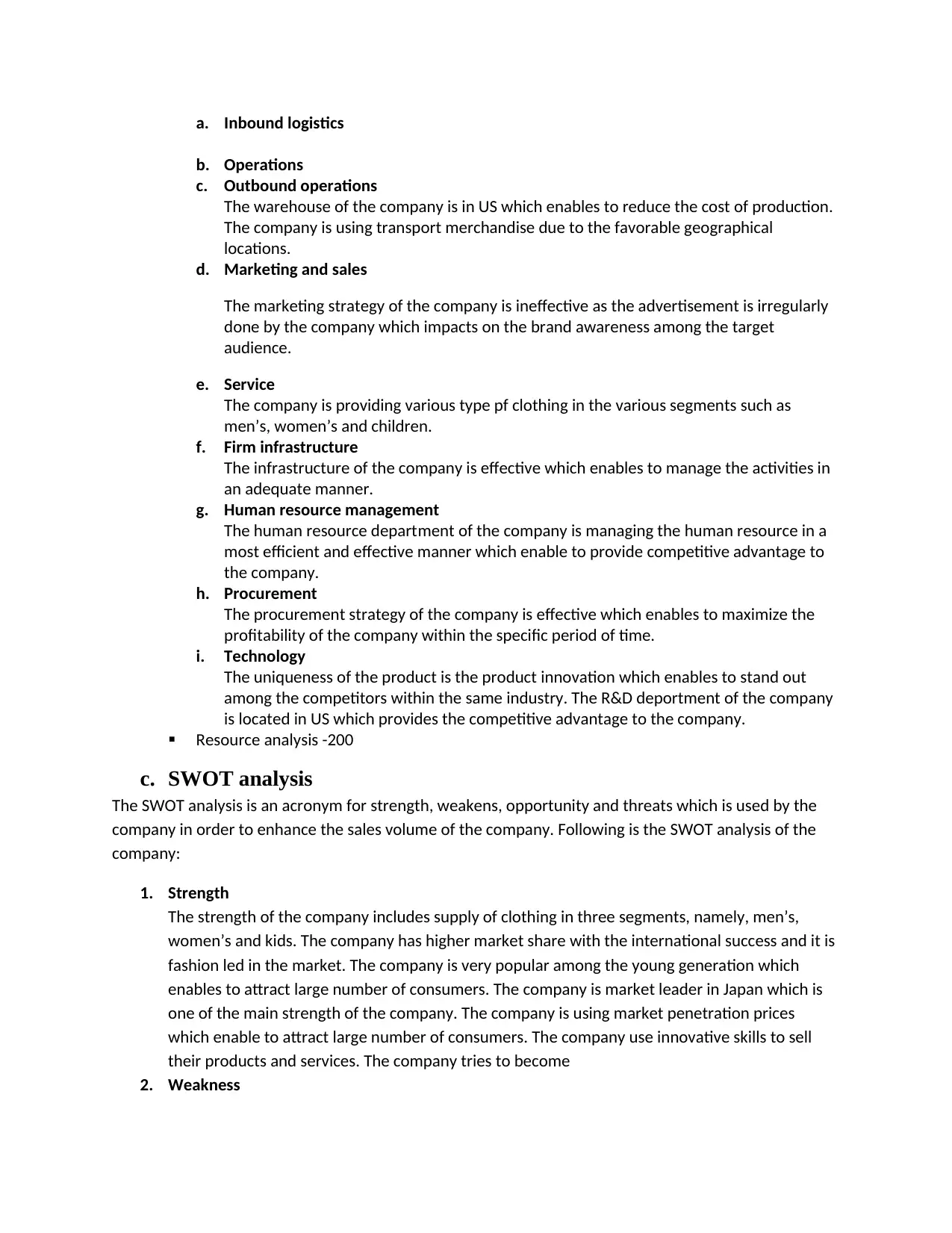
a. Inbound logistics
b. Operations
c. Outbound operations
The warehouse of the company is in US which enables to reduce the cost of production.
The company is using transport merchandise due to the favorable geographical
locations.
d. Marketing and sales
The marketing strategy of the company is ineffective as the advertisement is irregularly
done by the company which impacts on the brand awareness among the target
audience.
e. Service
The company is providing various type pf clothing in the various segments such as
men’s, women’s and children.
f. Firm infrastructure
The infrastructure of the company is effective which enables to manage the activities in
an adequate manner.
g. Human resource management
The human resource department of the company is managing the human resource in a
most efficient and effective manner which enable to provide competitive advantage to
the company.
h. Procurement
The procurement strategy of the company is effective which enables to maximize the
profitability of the company within the specific period of time.
i. Technology
The uniqueness of the product is the product innovation which enables to stand out
among the competitors within the same industry. The R&D deportment of the company
is located in US which provides the competitive advantage to the company.
Resource analysis -200
c. SWOT analysis
The SWOT analysis is an acronym for strength, weakens, opportunity and threats which is used by the
company in order to enhance the sales volume of the company. Following is the SWOT analysis of the
company:
1. Strength
The strength of the company includes supply of clothing in three segments, namely, men’s,
women’s and kids. The company has higher market share with the international success and it is
fashion led in the market. The company is very popular among the young generation which
enables to attract large number of consumers. The company is market leader in Japan which is
one of the main strength of the company. The company is using market penetration prices
which enable to attract large number of consumers. The company use innovative skills to sell
their products and services. The company tries to become
2. Weakness
b. Operations
c. Outbound operations
The warehouse of the company is in US which enables to reduce the cost of production.
The company is using transport merchandise due to the favorable geographical
locations.
d. Marketing and sales
The marketing strategy of the company is ineffective as the advertisement is irregularly
done by the company which impacts on the brand awareness among the target
audience.
e. Service
The company is providing various type pf clothing in the various segments such as
men’s, women’s and children.
f. Firm infrastructure
The infrastructure of the company is effective which enables to manage the activities in
an adequate manner.
g. Human resource management
The human resource department of the company is managing the human resource in a
most efficient and effective manner which enable to provide competitive advantage to
the company.
h. Procurement
The procurement strategy of the company is effective which enables to maximize the
profitability of the company within the specific period of time.
i. Technology
The uniqueness of the product is the product innovation which enables to stand out
among the competitors within the same industry. The R&D deportment of the company
is located in US which provides the competitive advantage to the company.
Resource analysis -200
c. SWOT analysis
The SWOT analysis is an acronym for strength, weakens, opportunity and threats which is used by the
company in order to enhance the sales volume of the company. Following is the SWOT analysis of the
company:
1. Strength
The strength of the company includes supply of clothing in three segments, namely, men’s,
women’s and kids. The company has higher market share with the international success and it is
fashion led in the market. The company is very popular among the young generation which
enables to attract large number of consumers. The company is market leader in Japan which is
one of the main strength of the company. The company is using market penetration prices
which enable to attract large number of consumers. The company use innovative skills to sell
their products and services. The company tries to become
2. Weakness
⊘ This is a preview!⊘
Do you want full access?
Subscribe today to unlock all pages.

Trusted by 1+ million students worldwide
1 out of 14
Related Documents
Your All-in-One AI-Powered Toolkit for Academic Success.
+13062052269
info@desklib.com
Available 24*7 on WhatsApp / Email
![[object Object]](/_next/static/media/star-bottom.7253800d.svg)
Unlock your academic potential
Copyright © 2020–2025 A2Z Services. All Rights Reserved. Developed and managed by ZUCOL.





